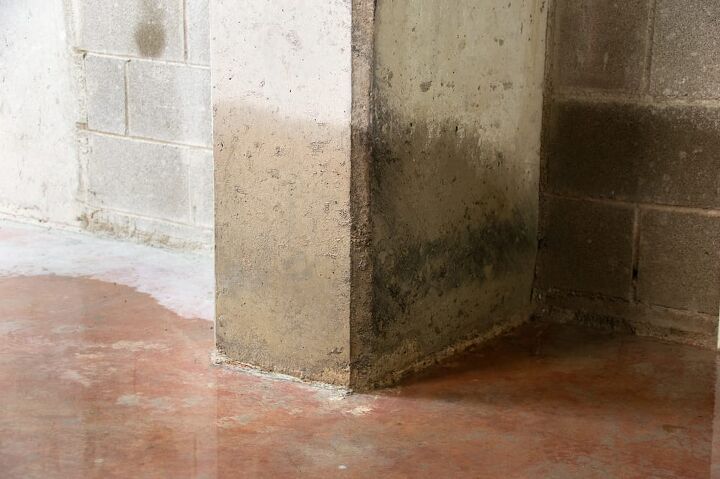How To Dry Concrete Floor After Water Leak (Quickly & Easily!)

There are a few things that homeowners never want to see. High up on that list is water damage. Leaks and invading water can make for a nightmare scenario for homeowners. The possibilities as it pertains to damage are seemingly endless.
Clear the area, mop and remove standing water, use a wet/dry vac, open windows, and use a fan. Place a dehumidifier in the area to help pull moisture from the air. Keep your home warm and use a heat-drying treatment to quickly dry a concrete floor after a flood.
Do You Need Water or Pest Damage Repair?
Get free, zero-commitment quotes from pro contractors near you.

Concrete Does Need to Be Dried Past the Surface
Some wrongfully believe that concrete is fully dried when you can’t see standing water on the surface. But that is not necessarily the case. And despite its ability to stave off water damage, concrete is not invulnerable.
Not only that, when concrete is not given the chance to completely dry, it becomes further vulnerable. It is susceptible to further damage in both the short and long term. That is why it is so important to ensure that it is completely dry before considering the issue resolved.
What Causes Concrete Water Damage?
Because concrete is able to resist water invasion so well, it takes something fairly substantial for water damage to be caused. Flooding is the most common reason, though the flooding itself can be the result of a plethora of issues.
The most notable issues involve issues with the plumbing system, including broken pipes. There may also be a build-up of water in areas that are prone to moisture like basements and crawl spaces. Foul weather, excessive melted snow, and other natural disasters are also fairly common. It basically comes down to large quantities of water or components within the concrete slab (like piping) that have become damaged or burst.
How to Dry Concrete Flooring After a Water Leak
While concrete is not quite as susceptible to water damage as some other materials, you should act fairly quickly. There are a couple of proven methods for getting your concrete dry again. When in doubt, a professional service can come out and take care of the issue in short order and will ensure that all the water has been removed.
Step 1: Remove Objects, Furniture, or Carpeting
Depending on the area of the home in which the water invasion happens, the floors will be bare. That said, some people lay down carpeting or put furniture over concrete flooring to make it more comfortable and inviting.
Start by removing anything that could be preventing the concrete from drying. Soaked carpeting is a worst-case scenario because there is likely no salvaging it. Toss the wet carpet (if you keep it, mold growth becomes a real possibility) and remove any items or furniture as well.
When you remove furniture, ensure that it is properly dried. In most cases, letting them air dry should be enough but you may need something like a steam cleaner to get the job done properly. With nothing holding the moisture in, you can move to the next step in the process.
Step 2: Remove Any Standing Water
It may seem obvious but your concrete walls and flooring can’t properly dry if there is still water in the area. Any excess or visible water should be addressed sooner rather than later. The good news is that it will mostly pool on the surface of the concrete, making for easier removal.
You can typically get this done through a variety of avenues. Mopping is usually pretty good, though not many people have a traditional mop anymore. You can also use a wet-dry vac to suck up as much of the water as possible.
By removing as much of the excess water as you can, you minimize the potential for damage. Not only that, but you help to expedite the drying process that will be applied further on.
Step 3: Air Circulation
Depending on the severity of the water issue, you have two choices. The first simply allow air flow into the space so that it can dry the natural way. This is both the easiest and cheapest way of getting your concrete walls or flooring dry.
If there are windows in the space, open them up and let the fresh air naturally remove the moisture. Having proper ventilation will also speed up the process. Keep in mind that this method takes longer than some of the others, but you can’t beat a free fix.
Should there be no ventilation or windows – perhaps a basement – then you are looking at a different solution.
Step 4: Fans and Dehumidifiers
Not happy with the speed at which air flow dries the room? No windows to speak of to improve air flow? Break out the fans and a dehumidifier to get the job done. The principle is the same – improved air flow to pull the moisture out of the concrete.
The dehumidifier is more essential than the fans. It is capable of not only removing moisture and humidity from the air but giving the flooring a chance to dry thoroughly and properly. That reduces the risk of dampness and even mold growth. Just remember to exercise caution if the leak or flood was serious. Water and electrical plugs do not do well together.
Step 5: Running the Dehumidifier
Since the dehumidifier is such an important tool, you should be aware of how long to use it. It can substantially speed the process up, but that can lead to hurrying. Hurrying leads to leftover moisture which eventually causes problems.
Depending on other factors as well as the nature and extent of the damage, it can take a few days to a few weeks to completely dry out the damage done by a leak or flood. The dehumidifier will work to keep humidity levels under 50%, which essentially pulls moisture out of the air. That also discourages mold growth.
Give the dehumidifier the time that it needs to properly work. Make sure that all of the surfaces are completely dry before attempting to put furniture, carpeting, or anything else down on it again.
Step 6: Heat Drying
This can be a bit tricky and should be used as a last resort before going to a professional. That said, heating a wet surface (the concrete in this instance) can cause it to dry a lot quicker than it would with air circulation or even a dehumidifier.
It can be tricky, however. For starters, you have to heat the entire room. That’s not exactly the most efficient use of energy and can take some time. Furthermore, you have to keep the air warm enough to evaporate the moisture. When the air cools, the water vapor will condensate and then turn into a liquid again.
In order to heat the room, you need to have a consistent source of heat and make sure that it can’t escape. A fan is a great way to distribute the warm air throughout the room. A small heater could go a long way if it were given the time to run properly.
Step 7: Call in a Professional
Sometimes, despite best efforts, there may not be an effective way to get the concrete flooring fully dry. If you think that there may be underlying moisture, the only recourse at this point is to call in a professional.
They have the tools and experience necessary to ensure that your flooring is completely dry. Never just leave it be; if you think there is more moisture, address it. Moisture that is allowed to sit dormant can lead to bigger problems, like mold growth.
Do You Need Water or Pest Damage Repair?
Get free, zero-commitment quotes from pro contractors near you.

What is the Best Method?
It depends on your definition of “best.” If you are looking for a cheap way to get your concrete surfaces dry, there is nothing better than air circulation. If you are looking for something truly effective, though, grab a dehumidifier or even try the heating method.
At the end of the day, going with a professional may be best. They have the tools and knowledge to attack the problem properly. They may do something in a day or two that may take you a week or two.

Ryan Womeldorf has more than a decade of experience writing. He loves to blog about construction, plumbing, and other home topics. Ryan also loves hockey and a lifelong Buffalo sports fan.
More by Ryan Womeldorf














![The 10 Best Table Saws - [2022 Reviews & Buyer's Guide]](https://cdn-fastly.upgradedhome.com/media/2023/07/31/9070645/the-10-best-table-saws-2022-reviews-buyer-s-guide.jpg?size=350x220)












